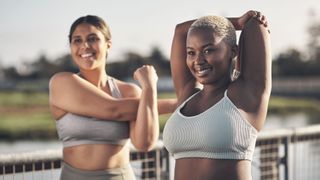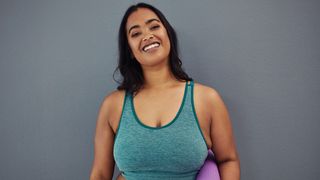Are sports bras bad for you?
We’re advised to wear them for exercise but are sports bras bad for you?

Do the benefits outweigh the negatives, or are sports bras bad for you? While sports bras have long been touted as an essential piece of exercise kit, there is another school of thought that suggests wearing a sports bra can weaken back muscles, cause shoulder pain, and even affect your posture.
However, experts in the breast health field have yet to see any evidence that wearing one of the best sports bras for running or any other form of physical activity is bad for you, and in fact, studies seem to suggest quite the opposite. When it comes to retaining breast shape and health, wearing a well-fitting sports bra when you exercise could be one of the best things you could do.
Far from being bad for you, sports bras can help with everything from how to avoid breast pain when running to ensuring you don’t damage the delicate breast tissue and ligaments when you’re vigorously stepping it out, and from a purely aesthetic perspective, they can help you avoid saggy boobs too.
According to the experts, exercise feels harder when breasts are not properly supported, so if you’re serious about your training, a decent sports bra is likely something you’re not going to do without. From what happens to our breasts during exercise to whether sports bras can improve performance, we spoke to the professionals to help put the question of ‘are sports bras bad for you?’ to bed once and for all.
Should you wear a sports bra?
Did you know that the G-force experienced by your breasts when performing high impact physical activity is greater than that of an F1 racing car? According to a study from the School of Sport, Health and Exercise Science, our breasts can come under a lot of pressure when we exercise, which begs the question, are you wearing the right support for your workout?

Padded, underwired, overband, mesh lining, divided cups, adjustable straps — when it comes to picking a sports bra, there’s a lot to think about. However, they can be tight and restrictive, so are sports bras bad for you, or are they a necessity if you want to retain the shape and health of your breasts?
“I have not seen any evidence to show that wearing a sports bra is bad for you,” states Professor Joanna Wakefield-Scurr, a Professor in Biomechanics and Head of the Research Group in Breast Health at the University of Portsmouth. “The only caveat to that is that your sports bra needs to fit well. It’s the same for shoes, you can have the best shoes in the world, but if they’re the wrong size for you, then they won’t function optimally, and you’ll suffer negative side effects.”
A poor quality sports bra could lead to some unfortunate health conditions, such as jogger's nipple, while a properly fitted bit of kit will help you avoid breast pain when running.
What happens to your breasts during exercise
Professor Wakefield-Scurr is the leading authority in breast movement during physical activity and the performance implication of having poor bra support. She set up her unit in the UK 17 years ago after discovering that there were only six published scientific studies looking at the support requirements for breasts. She has been leading the charge for women’s breast support ever since and her findings have led to significant shifts in what’s now available from retail brands.

“Our breasts are made up of ligaments and tissue and not having the right breast support can damage these supporting structures and means boobs don’t return to their original shape. In our lab we are currently trying to identify how much skin can stretch before it becomes damaged.
There’s a threshold for stretching human skin and that’s thought to be about 60 per cent. This means if you took a 10cm piece of skin and stretched it 16cm (60 per cent), that piece of skin would recover and go back to its original 10cm shape. However, if you stretched it beyond that, it would cause micro-traumas to the collagen in the skin, and this is when things like stretch marks occur. In our lab we have seen breast skin stretch up to 114 per cent during high impact activity.”
Another notable discovery has been that breasts move in a figure of eight pattern when we run. This particular study, from the University of Portsmouth, involved 15 D-cup participants and looked at the trajectory of breast displacement in three dimensions during the walking and running gaits. ‘During the running cycle, the breast followed a figure-of-eight pattern with four movement patterns,’ says Professor Wakefield-Scurr. “A bit like an infinity sign.”
Professor Wakefield-Scurr has also recorded that breasts can move up to 21cm during high impact activity, which as any big-busted female will know, can be incredibly uncomfortable during exercise. Research from the Breast Journal shows that 72% of active women report exercise-induced breast pain, so, it’s little wonder that insufficient support is reported as one of the barriers to women exercising.
Can sports bras improve performance?
If you’re still not sold on the health benefits of wearing a sports bra, there’s also better performance to think about, too. “We did a study looking at running mechanics and we found that if you’re wearing poor support, then it reduced your stride length by 4cm,” says Professor Wakefield-Scurr.
“This might not sound like a lot, but if you equate that over a marathon distance, 4cm equates to one mile. We have also noticed the effects of good support on things like breathing frequency, heart rate, shoulder and pelvic rotation and technique so there are lots of biomechanical factors that can be affected by poor support.”

Thankfully, big brands like Adidas are now offering more diverse ranges so women can really tailor their support needs. The brand spent two years re-engineering its collection of sports bras to support all body shapes and boob sizes, launching 43 new styles earlier this year. It worked closely with the University of Portsmouth, using its insights, and now offers a diverse range for everything from gentle movement to the highest level of breast support.
MAAREE is another rising star in women’s performance apparel having created patented technology to minimise the upward motion and boob bounce. Founder Mari Thomas studied Sports Technology at Loughborough University and after graduating, took a role as a sports bra tester and researcher advising some of the then biggest names in the business.
“I noticed that brands were concentrating solely on reducing the downward motion of breast tissue when running,” she says. “Yet breasts move in figure-of-eight motion when we run so this felt short-sighted and I wanted to create something that minimised the upward motion of the breasts as well. The resultant reduction in the downward motion would lead to a reduction in overall breast motion.” And so MAAREE’s Overband Technology was born - a stiffened panel that runs over the top of the chest and is anchored into the underband.
Whatever your sporting preference, Professor Wakefield-Scurr, says a good sports bra should be all about support and adjustability. Therefore, it can be adapted for asymmetrical breasts and size changes during the menstrual cycle etc. “Jump around in the changing room, wave your arms, jog on the spot, just make sure it’s good support for you,” she adds.
If you have larger breasts and require some additional support, our roundup of the best sports bras for large breasts deals has got you covered.
Further reading
Sign up for the Live Science daily newsletter now
Get the world’s most fascinating discoveries delivered straight to your inbox.
Vicki-Marie Cossar is a Surrey-based freelance journalist who has more than 20 years experience writing across the topics of health, fitness, fashion, beauty and wellbeing. Her content includes investigative news stories, feel-good features and trend reports/predictions. She was formerly responsible for the Life & Style section of Metro newspaper’s features department (now called Trends) and currently writes the paper's weekly Wellbeing supplement.
Vicki-Marie juggles her passion for writing around after her 4-year-old twin girls and in her (very limited) downtime, she finds headspace walking her chocolate Labrador or running/strength training in her home gym.

